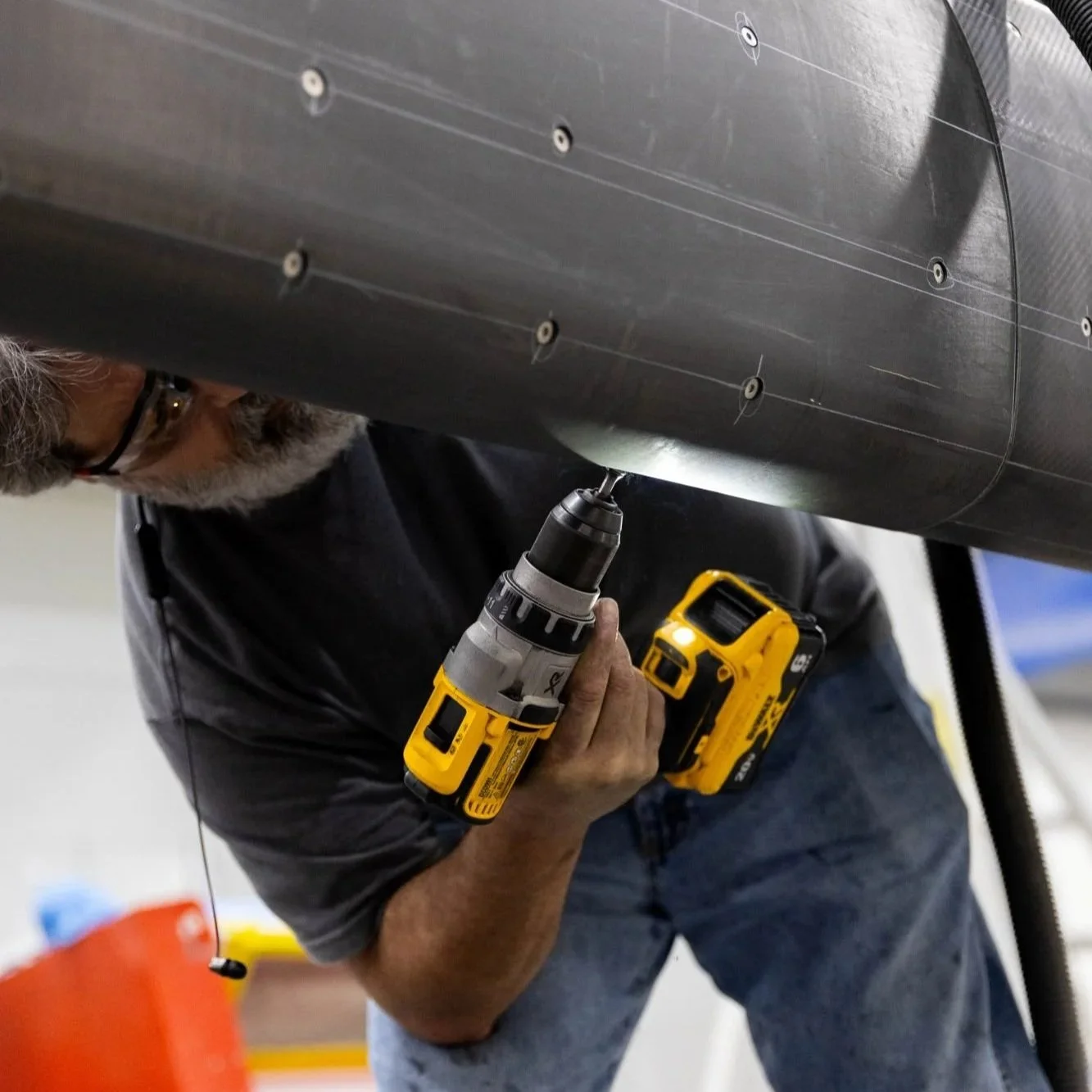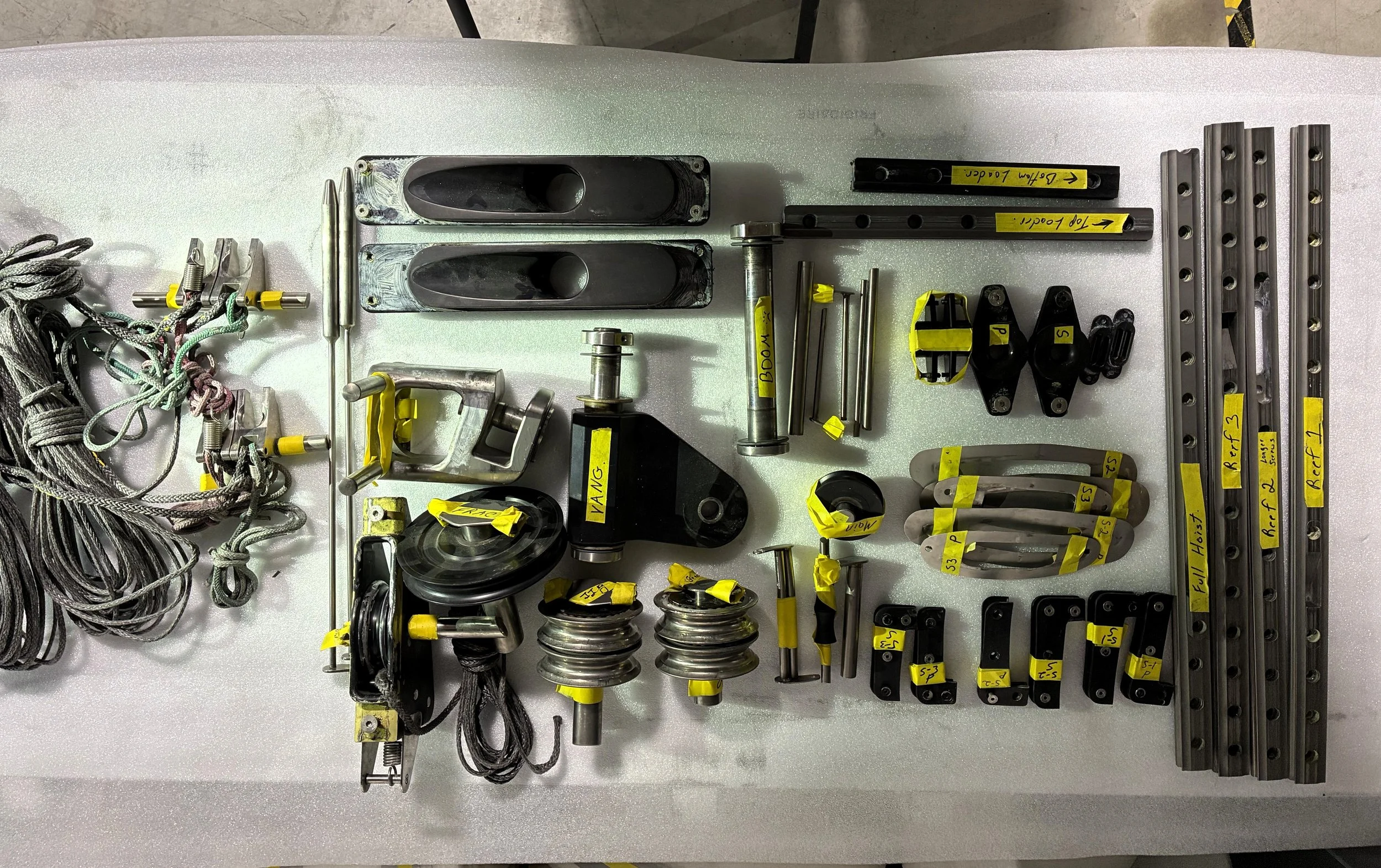After a big push to wrap up the REGENT project in February, the Moore Brothers team has been diving into some other marine projects, including some technical mast repairs. Thanks to the recent purchase of a larger CNC machine and the hiring of veteran CNC operator, Ben Classen, Moore Brothers will now be able to expand their production even further.
STP 65
A STP ‘65 had a rigging failure while racing and subsequently had the mast “break pretty much right in the middle of the second spreader,” said Henry Maxwell, project manager at Moore Brothers. Maxwell explained that they are building a splice sleeve out of carbon to connect the two halves.
“It's quite an engineering feat done by Gunnar,” said Maxwell about the work that Moore Brother’s engineer, Gunnar Salkind did to figure out how to do the repair in a way that's first off safe, but also done in a thoughtful manner. “It's a full on Grand Prix race boat that you want to try to repair in a way that's not going to impact the quality or the performance of it.” He said.
Obviously, the objective was not to add a lot of weight to the mast through the use of extra carbon fiber. “If you just throw a lot of carbon at it, it [the mast] becomes very stiff and inconsistent.” Maxwell explained. Trying to balance the amount of carbon with the need for the mast to be able to bend with the pull of sails was essential. “Gunner spent a lot of time engineering the repair to make sure there was the least amount of impact to the overall performance after it's done.” Maxwell explained.
Dissassembly in preparation for a repair, the team sorts and labels the STP 65 Mast Hardware
Maxwell flew out to Michigan, where the boat is in January, to meet with the owner and take measurements as well as to survey all the interface points. Salkind and Maxwell had in fact worked on the original rig for the boat years ago, back in 2010. Since then, the boat has had multiple owners. “I did all the engineering. So I know that rig inside and out.” Salkind explained. But the hydraulic system had changed, so Maxwell needed to check all this out on his trip to Michigan.
“The nice thing is we have Gunnar to do the in-house composite engineering, and then we have the CNC capability to make tools to replace the section that was damaged.” Said Jacques Swart, Moore Brothers’ sales representative. “Then we have the skilled labor to physically scarf and splice that mast back together so that they can use it. You know, the alternative would have been for them to have to get a completely new mast.”
Swart explained that Moore Brothers’ CNC equipment allows them to essentially make any shape or tool in house. “We had to make the tool to enable us to make the replacement piece and then they do the physical lamination and splicing of the new piece of that mast.” He said.
Swart explained that the older race boats often don’t have the same value as they used to, “so insurance companies might just write the boat off, or the owners might decide to take a payout.” He explained. “And then these beautiful state-of-the art race boats of their time kind of just get put out to pasture. So this way you can keep a great boat relevant and active for a period of time rather than people just walking away.”
Since starting work on this mast, Moore Brothers has also started work on increasing the length of the bowsprit.
Bolt 37
Another race boat, but of a smaller size, although not any less complicated. “It had a compression failure below deck where the carbon just kind of compressed together.” Maxwell explained. This led to the mast breaking lower down. “So we cut away back to good material and then built a new bottom section, and spliced it back together and put all the hardware back on.”
In order to fix the mast, the team had to start from scratch.“What we did was create a tool of our own that matches the shape that we need to replace the piece that broke.” Sulkind explained. “We had all the CNC capability to do that in-house.”
One thing that Swart highlighted is that, “once the NDT (nondestructive testing) has been done and everything, and had the mast been found to be not repairable, we also have the capacity and capability and skillset to build a new mast for any of these projects.”
But the good news is that it is already back in Essex, Connecticut with the owner who is in fact a rigger!
Swan 68
“This one's a much bigger repair that had a failure rate at the gooseneck area.” Maxwell explained. “We're going to build a whole new lower section and then splice it back together.” Although the build is complex, Maxwell is confident that the team will be able to get it done, thanks to the expertise on the floor and the engineering team. “I mean, without a doubt, having Gunner– we wouldn't be able to do this without him.” He said. “ It's his experience and diligence on these projects. He holds us all to a very high level, which is great.”
Maxwell also highlighted how Moore Brothers has reached a new level of expertise and quality, thanks to additions to the team and the expansion of CNC capability. “The infrastructure within the company and having the large CNC machines, we're able to make the tools to build the repair parts that other companies just don't have that ability to, because you would need the original manual to really build this stuff,” he said. “But with careful scanning and measurements, we can. We can build anything we want with time and the right people. It's pretty impressive. It's far more, far more impressive than any other company I worked for. There's really a ‘can do’ attitude about it.”






